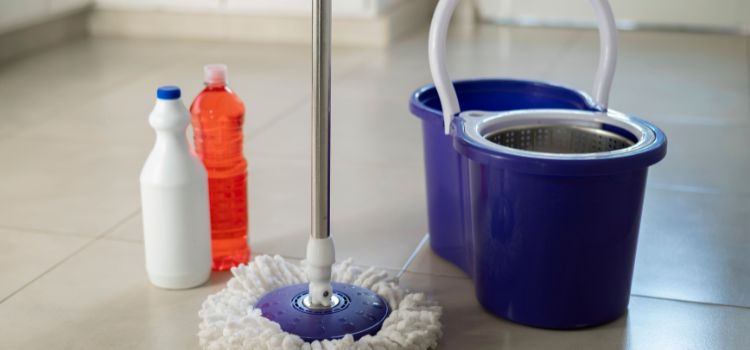As an Amazon Associate I earn from qualifying purchases.
Steam mop use has increased as people want a more hygienic and clean house. They guarantee that they can clean floors with just steam and no harsh chemicals. Nonetheless, many people are curious whether they may increase the steam mop’s cleaning efficacy by mixing in some vinegar. This article explores the safety concerns of using vinegar in a steam mop and whether it can be done.

Introduction
Many people in today’s environmentally aware world are curious about whether vinegar may be used in a steam mop due to the growing search for natural cleaning solutions. The aim to clean thoroughly without harsh chemicals has led to the question. Given its reputation as a disinfectant, vinegar is a great fit. However, it’s crucial to comprehend the nuances of this strategy before getting started.
Understanding the Composition of Vinegar
A multipurpose home staple, vinegar is well-known for its cleaning abilities. It has an acidic pH, usually ranging from 2.5 to 3.0. Because of its acidity, vinegar is a great natural cleanser that may dissolve germs, mineral deposits, and dirt.
The Mechanism of Steam Mops
To create steam, steam mops heat water. After that, a pad directs this steam onto the floor, which aids in removing filth and debris. The heat from the steam also kills most germs and dust mites on the surface. Steam mops are made to clean using just pure, hot steam and no additional cleaning ingredients.
Can You Put Vinegar in a Steam Mop?
The quick response is that it needs to be advised. Although vinegar works well as a cleaner, its acidic composition may harm the interior parts of a steam mop. For several reasons, the majority of manufacturers expressly warn against putting anything other than water in the mop’s reservoir:
Corrosion: Over time, the steam mop’s metal components may corrode due to vinegar’s acidic nature, perhaps causing leaks or other issues.
Warranty invalidation: Using vinegar in your steam mop will invalidate the warranty since, in most cases, manufacturer rules consider this to be abuse of the device.
Effectiveness: Water is the ideal solvent for the steam mop’s design. Vinegar may or may not increase the cleaning efficacy and, in some situations, may leave a residue on your flooring.
Alternative Ways to Use Vinegar for Cleaning Floors
If you’re determined to use vinegar’s cleaning abilities on your floors, here are some more approaches to think about:
Pre-Cleaning Solution: Use a 1:1 combination of vinegar and water to pre-clean filthy surfaces. Next, use regular water to clean the area with your steam mop.
Hand Mop and Bucket: Use a conventional mop and bucket for a deeper vinegar clean. A vinegar and water solution works well for most floor types, but be sure to always follow the manufacturer’s instructions for your particular flooring.
Caring for Your Steam Mop
Use these maintenance suggestions to make sure your steam mop lasts a long time and works well:
Use Distilled Water: When using a steam mop, use distilled water to avoid mineral accumulation.
Regular Maintenance: To prevent mineral deposits from clogging the system, clean the mop pad after each use and describe the device as the manufacturer directs.
Read the Manual: Always consult the manufacturer’s instructions for advice on maintenance, upkeep, and use.
Final Words of Vinegar in a Steam Mop
Even though vinegar is an effective natural cleanser, using it in steam mops might result in damage and invalidate the warranty. But vinegar may still be helpful in your floor cleaning regimen when used in other ways. The most excellent method to guarantee your floors are clean and sanitized and that your equipment continues to function correctly while steam mopping is to follow the manufacturer’s recommendations and use water only. Years of efficient cleaning with your steam mop may be guaranteed if you follow the care and maintenance instructions.
FAQs
Yes, vinegar’s acidic nature may harm internal components of steam mops and rust metal parts, thus voiding the guarantee.
Manufacturers advise against using vinegar because it may cause corrosion, damage to the machine over time, and invalidate the equipment’s guarantee.
Indeed. For efficient floor cleaning, use a spray bottle filled with a vinegar and water combination or a standard mop and bucket.
Avoid using vinegar straight in the steam mop; use it as a pre-cleaning solution for problematic areas, or combine it with water for hand mopping.
Clean the mop pad after each use, use distilled water to avoid mineral accumulation, and perform routine maintenance as the manufacturer advises.
As an Amazon Associate I earn from qualifying purchases.








